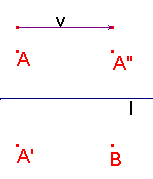|
§7.合同変換
§6に続いてここでもユークリッド平面上での議論である.
平面上のアフィン変換
$\begin{pmatrix}x'\\y'\end{pmatrix}
=\begin{pmatrix}a&b\\c&d\end{pmatrix}\begin{pmatrix}x\\y\end{pmatrix}
+\begin{pmatrix}p\\q\end{pmatrix}\cdots (\sharp)$
は点$(x,y)$を$(x,y,1)$とすれば
$\begin{pmatrix}x'\\y'\\1\end{pmatrix}
=\begin{pmatrix}a&b&p\\c&d&q\\0&0&1\end{pmatrix}
\begin{pmatrix}x\\y\\1\end{pmatrix}\cdots (\flat)$
となる.アフィン変換は$(\flat)$の方が扱いやすい.
ユークリッド平面$\mathbb{R}^2$の距離を保つ変換,すなわち平行移動,回転移動,対称移動またはこれらの合成は初等幾何的取り扱いが一般的であるが,
ここでは$(\flat)$を用いて解析幾何的取り扱いを行う.
ユークリド平面$\mathbb{R}^2$の距離を保つ基本となる変換は次の3つである.
1.平行移動
$x$軸方向に$a$,$y$軸方向に$b$だけ平行移動する変換を$P_{(a,b)}$と表す.
$P_{(a,b)}$を行列で表すと
$\begin{pmatrix}x'\\y'\\1\end{pmatrix}
=\begin{pmatrix}1&0&a\\0&1&b\\0&0&1\end{pmatrix}
\begin{pmatrix}x\\y\\1\end{pmatrix}$
2.回転移動
原点の周りの回転角$\theta$の回転移動を$R_{\theta}$とする.
$R_{\theta}$を行列で表すと
$\begin{pmatrix}x'\\y'\\1\end{pmatrix}
=\begin{pmatrix}\cos \theta&-\sin \theta &0\\ \sin \theta &\cos \theta&0
\\0&0&1\end{pmatrix}
\begin{pmatrix}x\\y\\1\end{pmatrix}$
3.対称移動
$x$軸と$\theta$をなす直線,すなわち$y=(\tan \theta )x$に関する対称移動を$T_{\theta}$
とする.
$T_{\theta}$を行列で表すと
$\begin{pmatrix}x'\\y'\\1\end{pmatrix}
=\begin{pmatrix}\cos 2\theta&\sin 2\theta &0\\ \sin 2\theta &-\cos 2\theta&0
\\0&0&1\end{pmatrix}
\begin{pmatrix}x\\y\\1\end{pmatrix}$
まず,点$A(a,b)$のまわりの回転角$\theta$の回転移動を求めよう.
通常は$(x,y)\mapsto (x',y')$とすると$(x-a,y-b)$と$(x'-a,y'-b)$の関係より
$\begin{pmatrix}x'-a\\y'-b\end{pmatrix}
=\begin{pmatrix}\cos \theta&-\sin \theta \\ \sin \theta &\cos \theta
\end{pmatrix}
\begin{pmatrix}x-a\\y-b\end{pmatrix}$
とするが,ここでは平行移動と回転移動の合成である
$P_{(a,b)}\circ R_{\theta}\circ P_{(-a,-b)}$
として行列で表示する.
$\begin{pmatrix}x'\\y'\\1\end{pmatrix}
=\begin{pmatrix}1&0&a\\0&1&b\\0&0&1\end{pmatrix}
\begin{pmatrix}\cos \theta&-\sin \theta &0\\ \sin \theta &\cos \theta&0
\\0&0&1\end{pmatrix}
\begin{pmatrix}1&0&-a\\0&1&-b\\0&0&1\end{pmatrix}
\begin{pmatrix}x\\y\\1\end{pmatrix}$
$=\begin{pmatrix}\cos \theta&-\sin \theta &a(1-\cos \theta)+b\sin \theta\\ \sin \theta &\cos \theta&-a\sin \theta +b(1-\cos \theta)
\\0&0&1\end{pmatrix}\begin{pmatrix}x\\y\\1\end{pmatrix}$
ここで$x_0,y_0$を
$\begin{cases}
x_0=a(1-\cos \theta)+b\sin \theta \\
y_0=-a\sin \theta +b(1-\cos \theta)\end{cases}
$
とおく.すなわち
$\begin{pmatrix}x_0\\y_0\end{pmatrix}
=\begin{pmatrix}1-\cos \theta&\sin \theta \\-\sin \theta &1-\cos \theta
\end{pmatrix}\begin{pmatrix}a\\b\end{pmatrix}\cdots (\natural)$
である.
$\begin{pmatrix}1-\cos \theta&\sin \theta \\-\sin \theta &1-\cos \theta
\end{pmatrix}^{-1}=\dfrac{1}{2(1-\cos \theta)}\begin{pmatrix}1-\cos \theta &-\sin \theta\\
\sin \theta &1-\cos \theta \end{pmatrix}$
$1-\cos \theta =2\sin ^2\frac{\theta}{2},\sin \theta =2\sin \frac{\theta }{2}\cos \frac{\theta }{2}$であるから
$=\dfrac{1}{2\sin \frac{\theta}{2}}\begin{pmatrix}\cos (\frac{\pi}{2}-\frac{\theta}{2})&-\sin (\frac{\pi}{2}-\frac{\theta}{2})\\
\sin (\frac{\pi}{2}-\frac{\theta}{2})&\cos (\frac{\pi}{2}-\frac{\theta}{2})\end{pmatrix}$
したがって
$\begin{pmatrix}a\\b\end{pmatrix}=\dfrac{1}{2\sin \frac{\theta}{2}}\begin{pmatrix}\cos (\frac{\pi}{2}-\frac{\theta}{2})&-\sin (\frac{\pi}{2}-\frac{\theta}{2})\\
\sin (\frac{\pi}{2}-\frac{\theta}{2})&\cos (\frac{\pi}{2}-\frac{\theta}{2})\end{pmatrix}
\begin{pmatrix}x_0\\y_0\end{pmatrix}\cdots (1)$
これは,変換
$\begin{pmatrix}x'\\y'\\1\end{pmatrix}
=\begin{pmatrix}\cos \theta&-\sin \theta &*\\\sin \theta &\cos \theta&*
\\0&0&1\end{pmatrix}
\begin{pmatrix}x\\y\\1\end{pmatrix}\cdots (2)$
ただし,$*$は任意の数,$\theta \neq 0$
はある点$P$の周りの回転移動で,点$P$は$(1)$で与えられる.
さらに,平行移動と回転移動の合成や,2つの回転移動の合成(中心が異なる場合も含む)は
$(2)$の形で表せるから,次の定理が成り立つ.
定理
平行移動と回転移動の合成や,2つの回転移動の合成はある点の
周りの回転移動で表せる.
この定理を証明するだけなら,上の$(\natural)$で,
$\bigl(\begin{smallmatrix}1-\cos \theta & \sin \theta \\ -\sin \theta &1-\cos \theta \end{smallmatrix}\bigr)$
が逆行列を持つことを示すだけでよいから簡単である.
次に,対称移動についても回転移動と同じような議論をしよう.
直線$y=\tan \theta (x-a)$に関する対称移動は,
$P_{(a,0)}\circ T_{\theta}\circ P_{(-a,0)}$
であるから,この変換を行列表示すると
$\begin{pmatrix}x'\\y'\\1\end{pmatrix}
=\begin{pmatrix}1&0&a\\0&1&0\\0&0&1\end{pmatrix}
\begin{pmatrix}\cos 2\theta&\sin 2\theta &0\\ \sin 2\theta &-\cos 2\theta&0
\\0&0&1\end{pmatrix}
\begin{pmatrix}1&0&-a\\0&1&0\\0&0&1\end{pmatrix}
\begin{pmatrix}x\\y\\1\end{pmatrix}$
$=\begin{pmatrix}\cos 2\theta&\sin 2\theta &a(1-\cos 2\theta)\\ \sin 2\theta &-\cos 2\theta&-a\sin 2\theta
\\0&0&1\end{pmatrix}\begin{pmatrix}x\\y\\1\end{pmatrix}$
である.
ここで
$\begin{pmatrix}a(1-\cos 2\theta)\\-a\sin 2\theta\end{pmatrix}
=-2a\sin \theta \begin{pmatrix}-\sin \theta \\ \cos \theta \end{pmatrix}$
$a\sin \theta$は2直線$y=(\tan \theta)x,y=(\tan \theta)(x-a)$間の距離である.
ベクトル$(-\sin \theta ,\cos \theta)$は直線$y=(\tan \theta)x$と垂直な方向であることに注意する.
したがって,対称移動と平行移動の合成$P_{(a,b)}\circ S_{\theta}$は平行移動の向きが対称移動の対称軸と垂直な時に限り,直線に関する対称移動となる.
このままでは,対称移動と平行移動の合成は対称移動では表せない.
新しく,すべり対称移動を定義する.
定義
平面上で,直線$l$と$l$に平行なベクトル$\overrightarrow{v}$が与えらえたとき,$l$
に関する対称移動$S_l$と$\overrightarrow{v}$で定まる平行移動$P_{\overrightarrow{v}}$の合成写像
$P_{\overrightarrow{v}}\circ S_l$を軸が$l$ですべりが$\overrightarrow{v}$のすべり対称移動という.
 この定義の中で,すべり対称移動を$P_{\overrightarrow{v}}\circ S_l$で定義した.
この定義の中で,すべり対称移動を$P_{\overrightarrow{v}}\circ S_l$で定義した.
まず,
$P_{\overrightarrow{v}}\circ S_l=S_l\circ P_{\overrightarrow{v}}$
が成り立つ.
それは,右図で
$A\mapsto A'\mapsto B,A\mapsto A''\mapsto B$
を比べれば明らかである.
行列を用いて示せば
直線$y=(\tan \theta )(x-a)$に関する対称移動を表す行列は
$\begin{pmatrix}\cos 2\theta&\sin 2\theta &2a\sin ^2\theta\\
\sin 2\theta &-\cos 2\theta &-2a\sin \theta \cos \theta\\0&0&1\end{pmatrix}$
$b(\cos \theta ,\sin \theta)$だけ平行移動を表す行列は
$\begin{pmatrix}1&0&b\cos \theta\\0&1&b\sin \theta\\0&0&1\end{pmatrix}$
であり,これらの2つの積はともに
$\begin{pmatrix}\cos 2\theta&\sin 2\theta &b\cos \theta+2a\sin ^2\theta\\
\sin 2\theta &-\cos 2\theta &b\sin \theta -a\sin 2\theta \\0&0&1\end{pmatrix}$
で一致する.
任意のベクトル$(x_0,y_0)$は
$(x_0,y_0)=a(\cos \theta,\sin \theta)+b(-\sin \theta ,\cos \theta)$
と表せるから
$\begin{pmatrix}\cos 2\theta&\sin 2\theta &x_0\\
\sin 2\theta &-\cos 2\theta &y_0 \\0&0&1\end{pmatrix}$
$=\begin{pmatrix}\cos 2\theta&\sin 2\theta &a\cos \theta -b\sin \theta\\
\sin 2\theta &-\cos 2\theta &a\sin \theta +b\cos \theta\\0&0&1\end{pmatrix}$
$=\begin{pmatrix}1&0&a\cos \theta \\0&1&a\sin \theta\\0&0&1\end{pmatrix}
\begin{pmatrix}\cos 2\theta&\sin 2\theta &-b\sin \theta\\
\sin 2\theta &-\cos 2\theta &b\cos \theta \\0&0&1\end{pmatrix}$
したがって,これは,直線に関する対称移動と直線と平行な方
への平行移動の合成すなわちすべり対称移動である.すなわち
$\begin{pmatrix}\cos 2\theta&\sin 2\theta &x_0\\
\sin 2\theta &-\cos 2\theta &y_0\\0&0&1\end{pmatrix}$
で決まる変換はすべり対称移動である.
$A=\begin{pmatrix}\cos \theta &-\sin \theta \\ \sin \theta &\cos \theta
\end{pmatrix}$
$B=\begin{pmatrix}\cos \phi &\sin \phi \\ \sin \phi &-\cos \phi
\end{pmatrix}$
のとき
$AB=\begin{pmatrix}\cos (\theta+\phi )&\sin (\theta+\phi ) \\ \sin (\theta+\phi ) &-\cos (\theta+\phi )
\end{pmatrix}$
$BA=\begin{pmatrix}\cos (-\theta+\phi )&\sin (-\theta+\phi ) \\ \sin (-\theta+\phi ) &-\cos (-\theta+\phi )
\end{pmatrix}$
であり
$\begin{pmatrix}A&\overrightarrow{x}\\0 \ \ 0&1\end{pmatrix}
\begin{pmatrix}B&\overrightarrow{y}\\0 \ \ 0&1\end{pmatrix}
=\begin{pmatrix}AB&A\overrightarrow{y}+\overrightarrow{x}\\0 \ \ 0&1\end{pmatrix}
$
対称変換の合成は,対称軸の交点の周りの回転移動であり,
$\begin{pmatrix}\cos \theta &\sin \theta &x_0 \\ \sin \theta &-\cos \theta &y_0\\0&0&1
\end{pmatrix}$
は対称移動かすべり対称移動であるから次の定理が証明された.
定理
平面上の平行移動,ある点の周りの回転移動,ある直線に関する対称移動の合成は,平行移動またはある点の周りの回転移動または
ある直線に関する対称移動またはすべり対称移動のいずれかである.
斉次座標の活用例として,平面における合同変換を扱ってみた.
ここで述べた内容は初等幾何としての方が分かりやすい.それは
平面の幾何学変換を参考にするとよい.
1.中心射影
射影幾何の目次
全体の目次
|